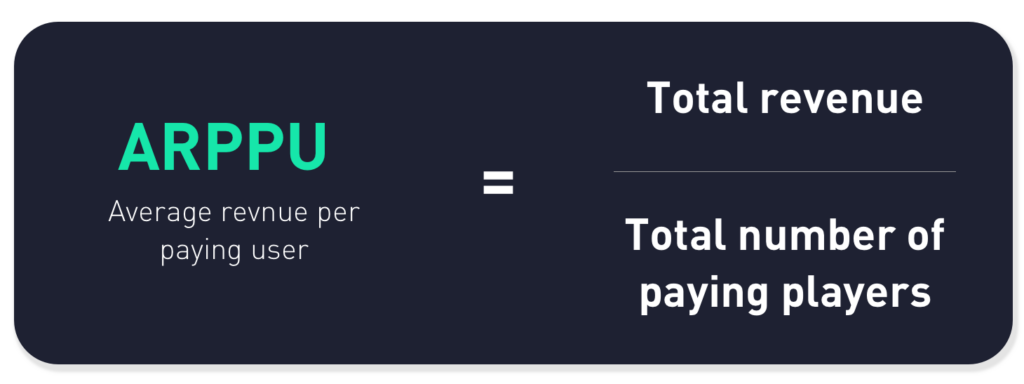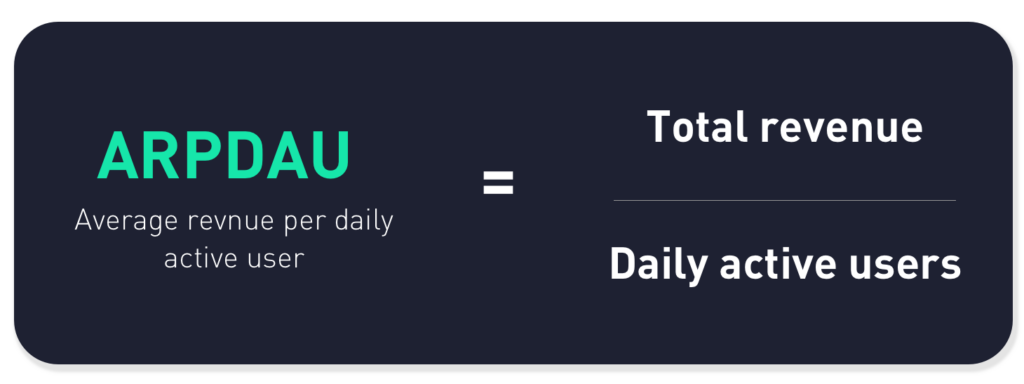· 7 min read
How to calculate ARPU, ARPPU, ARPDAU and more

Geetanjali Kaur
Senior Product Manager at GameAnalytics
Metrics like Average Revenue Per User (ARPU) or Daily Active Users (DAU) are like the coins you collect in a platformer: you want to rack them up, they’re sometimes fiddly to find and if you get enough they’ll give your game an extra life. Knowing these figures helps you figure out what you need to improve, predict how much you’ll earn, set yourself realistic targets and – fingers crossed – persuade investors to give you funding.
So how do you calculate and use them? This is the first part in our series on key metrics you’ll need to know and today we’re going to cover: DAU, ARPU, ARPPU and ARPDAU.
How to calculate DAU: Daily Active Users
Count the number of unique players doing any action in your app on each day.
1. You’ll need to decide on what defines your DAU
No two companies figure out their DAU in the exact same way. What counts as an active user for social media – where just opening it up and thumbing through your feed is enough – is going to be different to a game.
So ask yourself this: What is a user and what makes them active today? (Is it whether they downloaded your game and loaded it up once? Or they spent at least some time playing in the app? )
2. Use your DAU to know how many real players you have
It’s among your most useful metrics to see how many people are actually playing your game. If you just use the number of downloads, you’ll get some wacky results. Some players will download your game to multiple devices but actively play on one, others might download the game only to uninstall it immediately. Not helpful.
3. Be specific and honest with yourself
Just because someone opens up your game probably doesn’t make them an active user. (They might just have fat thumbs.) But you also don’t want to be too rigid. If you have an RPG game, maybe it’s enough that they loaded up a save? The more honest you are about what really counts as a player, the better you’ll be able to use the figure.
4. We look at how many players you have
We use ‘events’ to track various actions performed in a game. For example, ‘StartGame’ or ‘StartSession’ could be an event that you use. Each event is reported with the user’s ID.
So every day, we look at that list of unique players that have completed an event. This is what makes up your DAU. (You can read more about events here.)
5. Make changes if DAU is much lower than downloads
You’re always going to have people dropping off: they’ll finish the game or just slowly lose interest. That’s inevitable. But if your DAU trend looks to be going a lot lower, that probably means they didn’t enjoy it.
In that case, it’s one of a few reasons:
- Your advert was a bit misleading. If your ad doesn’t show off your gameplay properly, people will just hightail it out of there.
- Your first few levels aren’t working. You probably need to rethink your tutorial. Does it get too hard too quickly? Maybe it’s too easy?
- You’ve got too many ads. If people get bombarded with ads straight off the bat, they’re going to leave.
- You don’t have much replayability. Unless you’re Fortnite, people probably won’t stick around forever. But check your endgame. Do you have a reason for people to keep playing after they’ve ‘finished’?
Regardless of the reason, you probably need to run a few experiments to see if you can get people to stick around longer. You can use our new A/B testing feature to experiment here.
How to calculate ARPU: Average Revenue Per User

1. Find your return on investment
ARPU tells you how much you’re earning on average, and it’s best when you compare it to other data, like your marketing spend. If a $500 ad campaign gets you 10,000 new players, each one making you a buck: it was a good investment. But if you’re only getting a couple of cents a player, you probably need to change something. Either the ad or the game itself.
By itself, ARPU is helpful. But it’s most useful when you compare it to your ARPPU.
How to calculate ARPPU: Average Revenue Per Paying User

1. What is a paying user to you?
This might seem like an obvious question. But it can differ depending on your model. Is it someone who watches an ad? Buys a loot box? Buys the full game after your tutorial?
Obviously, if people pay upfront – and that’s it – it’ll be the same as your ARPU. But if they can buy extra cosmetics or currency, then it might be worth splitting those groups out.
2. Look at the difference between the two
Are your ARPU and ARPPU close? Great. That means most of your players are spending money. Do you see a gap? Then you need to think about why people aren’t paying once they’ve played. Perhaps your incentives aren’t very clear or maybe your business model doesn’t work for your genre.
You’re going to have a bunch of different player types. All with different playing behaviors, and more importantly, different spending habits. So it’s essential to understand the returns from ‘paying users’ and:
- treat them with extra TLC to get them to keep paying, and
- strategize on how to convert non-payers to payers
How to calculate ARPDAU: Average Revenue Per Daily Active User

1. How ARPDAU is different to ARPU and ARPPU
ARPU includes all users who have installed and used the app. ARPPU is if they have made at least one payment. While ARPDAU focuses on players who have actively engaged with your game every day.
2. Check whether it changes over time
This is where you can start to spot interesting fluctuations. Do people spend more on the weekend? Are they spending more after you do a big ad push – which probably means they’re spending in their first few hours? Or does it not get affected by a surge of newbies? (You probably have just a few people spending a lot: these are your whales.)
3. Get on the thinking cap
Now you know if and when things change, you can start coming up with ideas. Maybe you offer a discount on weekdays to encourage people to spend during your bad periods? Maybe you switch up your model, add in a battle pass to get more people to spend little amounts, and stop relying on those whales? Or maybe you just change up your prices and see if that’s the problem?
Every game is different
What works for a hyper-casual title is going to be different to an RPG. So it’s best to keep an eye on all these metrics. Compare them. Look between the numbers. And run experiments to see how you can improve them.
But most importantly, be honest with yourself. It doesn’t help anyone if you choose triggers that you know are going to get you higher figures.
Let’s improve those metrics together
Now you know what the metrics are, it’s time to start using them.
- Get your stats. You can find them all out through GameAnalytics. Sign up to our tool to see yours.
- Test out your ideas. Put on the safety goggles and run an A/B test to see what changes. Try out our A/B Testing.
We’re sure you’re keen to get started and we’re keen to see the results. So let us know how it goes. And if you fancy learning some more terms, have a read through our article on how calculate CPI, CPC, eCPM and more.